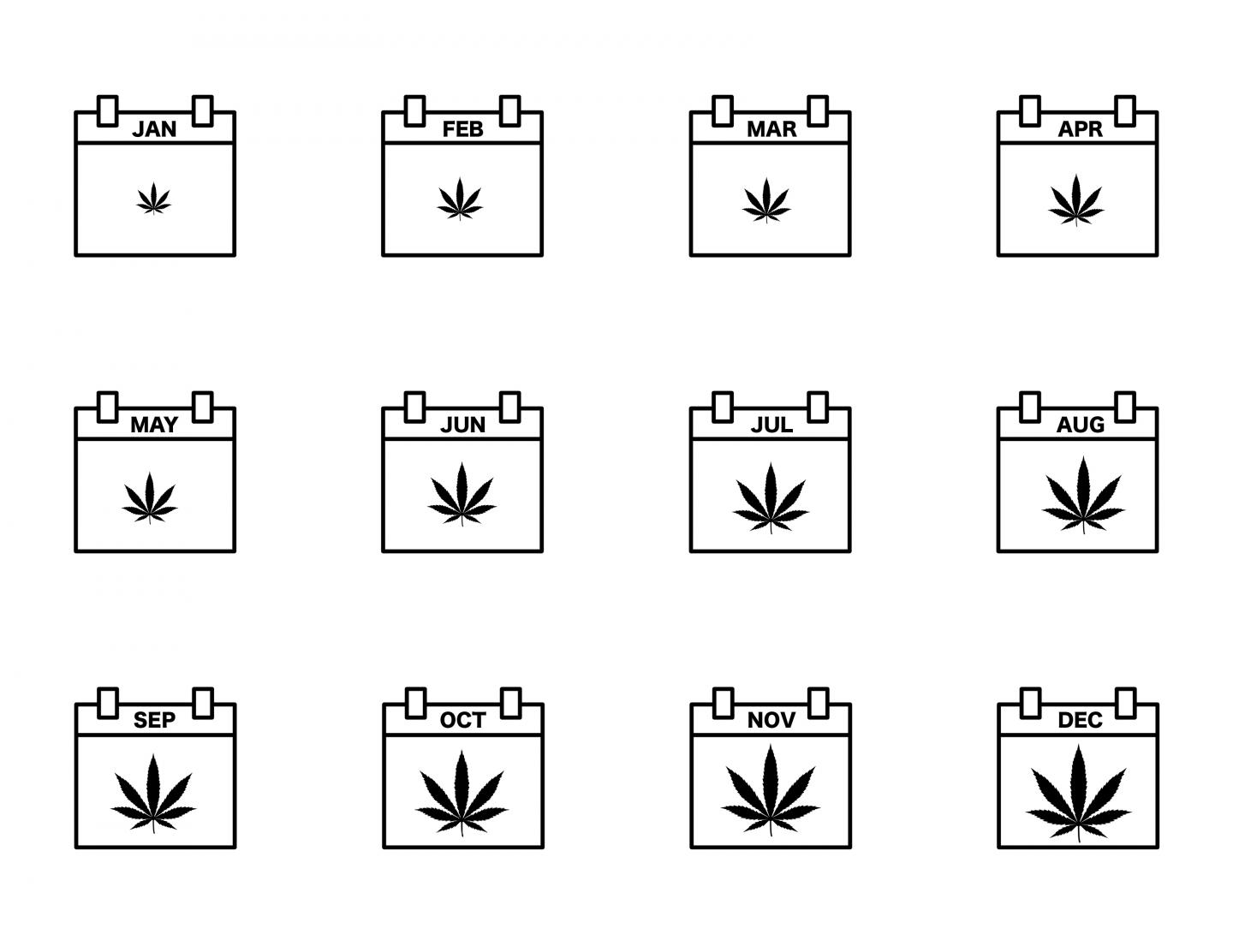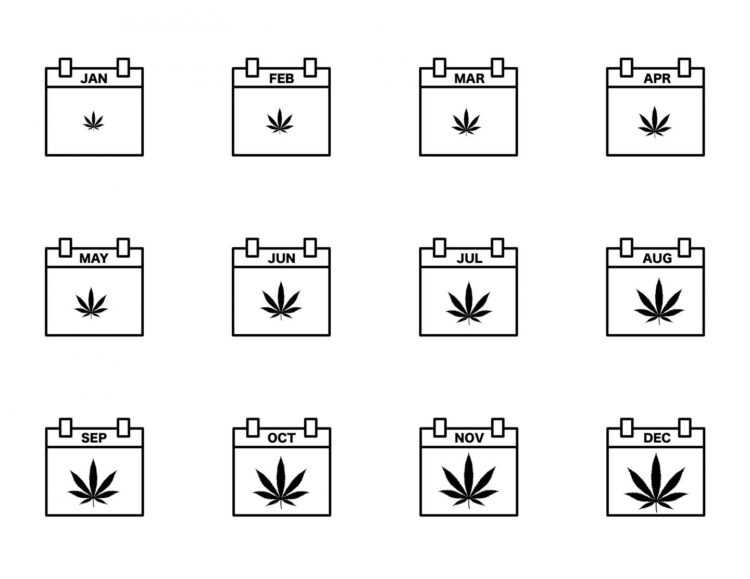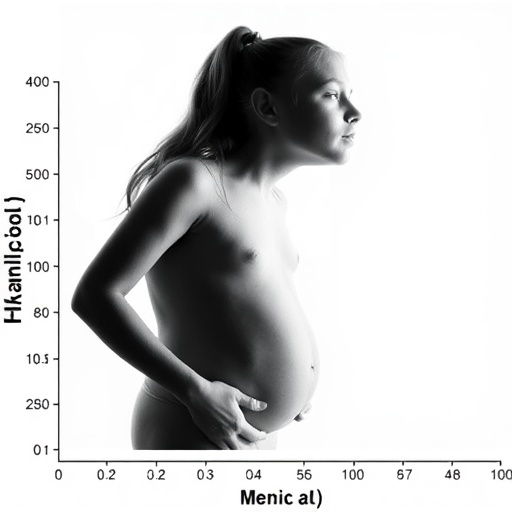Seasonal variation may be explained by new year’s resolutions

Credit: Image by Louliana Voelker for NYU; icons by Guilherme Furtado and Made (Noun Project) licensed as Creative Commons CCBY.
Marijuana use increases throughout the calendar year, with use up 13 percent on average at the end of each year (2015-2019) compared to the beginning, according to a new study published in the journal Drug and Alcohol Dependence.
“We found that marijuana use is consistently higher among those surveyed later in the year, peaking during late fall or early winter before dropping at the beginning of the following year. We think this may be due, in part, to a ‘Dry January’ in which some people stop drinking alcohol or even stop using marijuana as part of a New Year’s resolution,” said Joseph Palamar, PhD, MPH, an associate professor of population health at NYU Grossman School of Medicine, an affiliated researcher with the Center for Drug Use and HIV/HCV Research (CDUHR) at NYU School of Global Public Health, and the study’s lead author. “We’re now in the time of year when people are the least likely to use marijuana.”
Prior research shows that alcohol and drug use vary by time of year, with drug use often increasing during summer months, possibly due, in part, to social events. These seasonal variations can inform interventions–for instance, studies show that programs to reduce heavy drinking among college students should begin during the summer.
To better understand seasonal trends in marijuana use, Palamar and his colleagues analyzed data from 282,768 adolescents and adults who responded to the National Survey on Drug Use and Health from 2015 to 2019. The survey asked participants about their past-month use of marijuana and other substances, and the researchers estimated their use within each calendar quarter: January through March, April through June, July through September, and October through December.
Each year, as the calendar year progressed, marijuana use grew, increasing in summer and fall months before dropping as each new year began. While 8.9 percent reported using marijuana in January through March, 10.1 percent reported using in October through December, a 13-percent relative increase.
These seasonal trends occurred independently of annual growth in marijuana use and were seen across nearly all groups surveyed, regardless of sex, race/ethnicity, and education level. Teens were one exception; their marijuana use grew in the summer but declined in the fall months back to winter and spring levels.
Recreational use may be driving the growth throughout the year, as similar small increases occurred among those living in states with and without legal medical marijuana, and among those without a prescription for medical marijuana. Seasonal marijuana use also increased among those who reported using other substances, including alcohol, nicotine, and especially LSD.
The researchers note that the consistent dip in marijuana use during winter months could be a result of a variety of factors: a lower supply this time of year from cannabis harvests, colder weather keeping people inside who usually smoke outdoors, or people quitting marijuana as a New Year’s resolution.
“Ultimately, we hope that these findings can be utilized by researchers and clinicians alike,” said study coauthor Austin Le, DDS, a research associate at NYU Langone Health and orthodontic resident at NYU College of Dentistry. “Researchers studying marijuana use should consider seasonal variation, as surveys administered at the end of the year may yield different results than at the beginning of the year. And for those who wish to reduce marijuana use, it appears the best time for such targeting may be later in the year–when use is highest.”
In addition to Palamar and Le, Benjamin Han of the University of California, San Diego’s Department of Medicine, Division of Geriatrics co-authored the study. The research was supported by the National Institute on Drug Abuse, part of the National Institutes of Health (grants R01DA044207 and K23DA043651).
About CDUHR
The mission of the Center for Drug Use and HIV/HCV Research (CDUHR) is to end the HIV and HCV epidemics in drug using populations and their communities by conducting transdisciplinary research and disseminating its findings to inform programmatic, policy, and grass roots initiatives at the local, state, national, and global levels. CDUHR is a Core Center of Excellence funded by the National Institute on Drug Abuse (Grant #P30 DA011041). It is the first center for the socio-behavioral study of substance use and HIV in the United States and is located at the NYU School of Global Public Health. For more information, visit http://www.
About NYU Langone Health
NYU Langone Health is a world-class, patient-centered, integrated academic medical center, known for its excellence in clinical care, research, and education. Included in the 260+ locations throughout the New York area are six inpatient locations: Tisch Hospital, its flagship acute-care facility in Manhattan; Rusk Rehabilitation, ranked as one of the top 10 rehabilitation programs in the country; NYU Langone Orthopedic Hospital, a dedicated inpatient orthopedic hospital in Manhattan with all musculoskeletal specialties ranked top 10 in the country; Hassenfeld Children’s Hospital at NYU Langone, a comprehensive pediatric hospital, also in Manhattan, supporting a full array of children’s health services; NYU Langone Hospital–Brooklyn, a full-service teaching hospital and level 1 trauma center located in Sunset Park, Brooklyn; and NYU Langone Hospital–Long Island, a full-service teaching hospital and level 1 trauma center located in Nassau County on Long Island. Also part of NYU Langone Health is the Laura and Isaac Perlmutter Cancer Center, a National Cancer Institute-designated comprehensive cancer center; NYU Grossman School of Medicine, which since 1841 has trained thousands of physicians and scientists who have helped to shape the course of medical history; and NYU Long Island School of Medicine. For more information, go to nyulangone.org, and interact with us on Facebook, Twitter, YouTube, and Instagram.
About NYU School of Global Public Health
At the NYU School of Global Public Health (NYU GPH), we are preparing the next generation of public health pioneers with the critical thinking skills, acumen, and entrepreneurial approaches necessary to reinvent the public health paradigm. Devoted to employing a nontraditional, interdisciplinary model, NYU GPH aims to improve health worldwide through a unique blend of global public health studies, research, and practice. The School is located in the heart of New York City and extends to NYU’s global network on six continents. Innovation is at the core of our ambitious approach, thinking and teaching. For more, visit: http://publichealth.
# # #
###
Media Contact
Rachel Harrison
[email protected]
Related Journal Article
http://dx.





